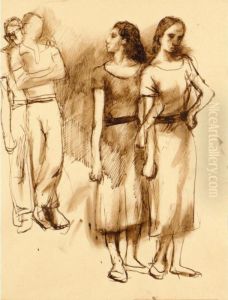Vassilii Nikolaevich Chekrygin Paintings
Vassily Nikolaevich Chekrygin was a Russian artist born on October 25, 1897, in the village of Sergeyevo, now in the Yaroslavl region of Russia. Chekrygin was a painter, graphic artist, and stage designer who belonged to the second generation of Russian avant-garde artists. His career, although brief due to his early death, was marked by a vivid and intense creativity that intersected with the turbulent events of the Russian Revolution and the Civil War.
Chekrygin began his artistic education at the Moscow School of Painting, Sculpture, and Architecture, where he studied from 1912 to 1917. His early work was influenced by Symbolism and Art Nouveau, but as the political and social landscape of Russia changed with the Bolshevik Revolution, so did Chekrygin’s artistic direction. He became associated with the left-wing art movement and participated in avant-garde exhibitions such as the 1919 'Exhibition of Pictures of 19 Living Artists' in Moscow.
In the early 1920s, Chekrygin was deeply involved with the revolutionary cultural milieu and worked in various capacities, including as a graphic artist for the ROSTA Windows, a Soviet institution responsible for creating propaganda posters. He also explored themes of spirituality and cosmic philosophy, which culminated in his ambitious work 'The Phenomenon of the Spirit,' also known as 'Non-Objective Creation and the Cosmic Ice Theory.' This unfinished painting, intended to be a monumental canvas, was inspired by the ideas of the spiritual teacher P. D. Ouspensky and reflected Chekrygin's interest in theosophy and esoteric knowledge.
Tragically, Vassily Chekrygin’s life was cut short when he drowned in a boating accident on the Volga River near Yaroslavl on July 11, 1922, at the age of 24. The loss of Chekrygin was felt deeply in the Russian avant-garde community as he was considered one of the most promising talents of his generation. Despite his short career, Chekrygin's work was influential in the development of Russian avant-garde art, and his legacy is preserved in Russian art history, with his works held in various museum collections, including the State Tretyakov Gallery in Moscow.
